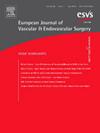Comparison of the Long Term Safety and Effectiveness of Endovascular Sac Embolisation and the Isolation Technique for Treatment of True Saccular Splenic Artery Aneurysms
IF 5.7
1区 医学
Q1 PERIPHERAL VASCULAR DISEASE
European Journal of Vascular and Endovascular Surgery
Pub Date : 2025-04-01
DOI:10.1016/j.ejvs.2024.11.018
引用次数: 0
Abstract
Objective
To compare the safety, effectiveness, hospital stay (HS), and total hospital cost (THC) of sac embolisation (SE) and the isolation technique (IT) for treating isolated saccular true unruptured splenic artery aneurysms (SAAs).
Methods
Two hundred and eight patients with isolated saccular true unruptured SAAs receiving endovascular SE or IT treatment at four medical centres in China between January 2016 and December 2022 were included retrospectively. Technical success rates, splenic infarction (SI) rates, aneurysm revascularisation (AR) rates, HS, and THC were compared between groups. Each group was divided into three subgroups, based on the size of the SAAs: 2.0 – 2.9 cm (S1), 3.0 – 3.9 cm (S2), and ≥ 4.0 cm (S3).
Results
Technical success was 100%. During a median follow up of 48.8 (IQR 33.0, 70.4) months, no patients had SAA rupture or died. The two and five year cumulative incidences of aneurysm revascularisation were 1.8% and 8.7% for the SE group and 2.2% and 2.2% for the IT group, respectively (p = .12). Compared with the SE group, the IT group had a higher SI rate (p < .001), a comparable AR rate (p = .12), a higher median HS (p < .001), and a lower median THC (p < .001). The median THC was comparable between the SE and IT groups in S1. The median THC of the SE group was approximately 1.36 times and 2.2 times of that in the IT group in S2 and S3 (both p < .001), respectively.
Conclusion
Sac embolisation and IT are safe and effective methods for treating isolated saccular true unruptured SAAs. The isolation technique seems to be superior in reducing THC, whereas SE may be superior in reducing SI rates and HS. Sac embolisation may be more suitable for smaller SAAs, whereas IT might be a better choice for larger SAAs.
比较血管内囊栓塞和隔离技术治疗真性脾动脉瘤的长期安全性和有效性。
目的比较囊栓塞(SE)和分离技术(IT)治疗孤立性囊状真性未破裂脾动脉瘤(SAA)的安全性、有效性、住院时间(HS)和住院总费用(THC):回顾性纳入2016年1月至2022年12月期间在中国4家医疗中心接受血管内SE或IT治疗的208例孤立性囊状真性未破裂脾动脉瘤患者。比较各组间的技术成功率、脾梗塞(SI)率、动脉瘤血运重建(AR)率、HS和THC。根据 SAA 的大小,每组分为三个亚组:结果:技术成功率为100%:技术成功率为 100%。中位随访时间为 48.8 个月(IQR 33.0,70.4),没有患者发生 SAA 破裂或死亡。SE组和IT组动脉瘤再血管化的两年和五年累计发生率分别为1.8%和8.7%,IT组为2.2%和2.2%(P = .12)。与 SE 组相比,IT 组的 SI 率较高(p < .001),AR 率相当(p = .12),HS 中位数较高(p < .001),THC 中位数较低(p < .001)。在 S1 中,SE 组和 IT 组的 THC 中值相当。在 S2 和 S3 中,SE 组的中位 THC 分别约为 IT 组的 1.36 倍和 2.2 倍(均 p < .001):囊腔栓塞和 IT 是治疗孤立性囊性真性未破裂 SAA 安全有效的方法。分离技术在降低THC方面似乎更胜一筹,而SE在降低SI率和HS方面可能更胜一筹。囊腔栓塞可能更适合较小的 SAA,而 IT 可能是较大 SAA 的更好选择。
本文章由计算机程序翻译,如有差异,请以英文原文为准。
求助全文
约1分钟内获得全文
求助全文
来源期刊
CiteScore
6.80
自引率
15.80%
发文量
471
审稿时长
66 days
期刊介绍:
The European Journal of Vascular and Endovascular Surgery is aimed primarily at vascular surgeons dealing with patients with arterial, venous and lymphatic diseases. Contributions are included on the diagnosis, investigation and management of these vascular disorders. Papers that consider the technical aspects of vascular surgery are encouraged, and the journal includes invited state-of-the-art articles.
Reflecting the increasing importance of endovascular techniques in the management of vascular diseases and the value of closer collaboration between the vascular surgeon and the vascular radiologist, the journal has now extended its scope to encompass the growing number of contributions from this exciting field. Articles describing endovascular method and their critical evaluation are included, as well as reports on the emerging technology associated with this field.

 求助内容:
求助内容: 应助结果提醒方式:
应助结果提醒方式:


